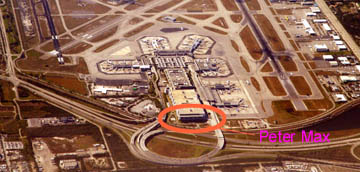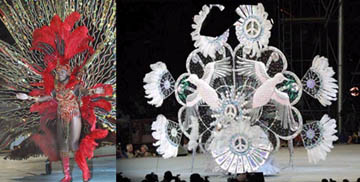I don’t type much about my professional work, but I have managed some public art programs and curated some exhibitions. Through this leadership, I have attempted to find the unique artistic forms of a community and celebrate them. “Artform of a community” could mean 1.) work by special local artists, 2.) visual art appreciated by at least one sub-culture group, and 3.) other locally appreciated arts or cultural attributes interpreted by visual artists. All artists making visual or spatial forms are welcome including painters, sculptors, musicians, quilt makers, landscape designers, architects, graphic designers, web designers, filmmaker, etc.
Sometimes an idea has passed through my skull that just seems like the “right thing to do.” Occasionally, the right thing has involved working with the wrong artists – according to the professional public artworld that is just now convincing a majority that modern art and integrated art are OK and that experienced public artists should design the work.
Two very inexperience public artists I wanted for the Fort Lauderdale Airport in Florida were Peter Max and Carnival King / Queen costumer makers from Trinidad. Peter Max did enter the competition for the new rental car parking facility, but lost to James Carpenter. I could not get anyone to take the costume makers seriously.
Peter Max is the most popular artist on cruise ships in the Caribbean and the Fort Lauderdale airport links operationally to the ship terminals. Hundreds of thousands of people fly to the airport and spend a week cruising with images from the 1960’s pop icon. He helped invent the visual imagery associated with late 1960s rock and roll – America’s most popular artform of the economically dominant baby boomer generation.
Peter Max prints available on cruise ships in Fort Lauderdale

Garage facade at entrance from cruise terminals and US 1
Yes, Peter Max had no official public art experience, but it would not be difficult for experienced architects to assist him and add his image to the main entry wall that is the size of a football field. But the problem was not his lack of experience, but his association with the money making side of the artworld. He is COMMERCIAL. Willing and ABLE to sell his images for T-shirts at a substantial royalty fee.
Of course selling T-shirts to tourists is a prime function of Fort Lauderdale beach retailers. Peter Max is one of the few artists that understands and could respond to the tourism industry – the engine that runs south Florida.
Not to deep below the surface in the public art establishment, a strong preference exists for selecting non-commercially successful artists. These artists ( curators and administrators ) think something is morally questionable about someone that strives aggressively to sell their art. It is assumed that normal public artists have an ethical superiority through their dedication to the site and/or community. These primarily untrue assumptions (judge the individual not his or her group) can have very little to do with finding the most valuable artworks for a community at the right moment. (Ironically, a few popular public artists ask for to $2,000 a day plus expenses.)
Several public art programs – especially at airports – have lined walls with display cases for creations other than public artworks. Frequently these cases will include traditional arts and crafts from the region, an admirable project. What is infrequent is commissioning those artists for large-scale works. The exception might be a pre-made system like the floor medallions at the National Airport in Washington, DC, where one fabricator took the artist drawings and converted them to terrazzo. This type of exception can steal the power of the original work through uniformity
Artists from Trinidad stitch together huge costumes of lightweight materials. The model must walk with the costume on his or her back. Self-taught artists in traditional and contemporary materials have converted the Kings and Queens Costume contest at the end of Carnival in Trinidad into a circus-like event. The costumes are translucent with fabrics, feathers and shiny reflective materials. Formally, the shapes and patterns radiate from the model.
Trinidad Carnival King Competition

Trinidad Carnival Queen Competition
The white visitors to south Florida generally throw all the people with dark skin into the generic “Black” category. People of African descent are their own black melting pot unlike other areas of the USA. Even in 1900, the African-Americans here were just as likely to be from the Bahamas as South Carolina. Today, it is very easy to find people whose families are from Jamaica, Haiti, Cuba, Dominican Republic, Bahamas, Brazil and all the small islands in the Caribbean Sea.
As is typical of a dominant culture anywhere, the flavor of the minority may be celebrated, but the people are ignored. Any cultural expression should be made in their assigned ghetto with nice names like “Little Haiti”. This race matching is still a bad habit in public art and other cultural realms.
The airport is a dominant culture zone despite the realty of the people flying and working. The prospect of many 15-foot diameter Trinidad costumes floating from the ceiling of the main terminal of the Fort Lauderdale airport might have been too powerful an image. Instead the history of the toy airplane is displayed (NOT a Broward County public art project.)
History of toy airplanes in Fort Lauderdale terminal
I started this essay when Google sent me a dispatch from India regarding the demand for “permanent” fiberglass Durga Puja sculptures instead of the temporary mud and straw icons. According to writer, Chandrima S. Bhattacharya, religious sculptures are being shipped to Indian communities worldwide as a religious symbol that is transforming into a cultural symbol. Indians in London or New York install these Durgas with her ten arms in hotel lobbies all year round instead of the temple or other gathering place for 5 days before completing the Hindu ceremony by throwing the artwork into a river.
Amar Nath Ghosh, a leading shoal-artist of Kumartuli, works on Durga sculpture
At the British Museum in 2006, artists from Indian made a traditional mud and straw Durga sculpture. At the end of the exhibition, the Hindu community took the sculpture to the Thames for the river’s first Durga Puja ceremony.
Both these events located outside of India by people of Indian descent start the change from religion to culture. The cultural leaders of the dominant and minority cultures actively participate in the removal of sacred attributes and focus on the visual splendor and associated myths and music. The religious symbols become neutralized.
In all three situations – Peter Max, Trinidad Costumes and Hindu icons – the realm of public art insist upon neutrality or a removal of any powerful emotions related to the sociological connotations of the work. Yet these connotations provide the deep power of the artwork.
How do we hold onto the power without scaring away the culturally fearful? Only by finding this answer do we stand a chance of inventing a new human diversity for the future of the planet. Through its civic ownership and physical locations, public art can be a testing ground.
King Costume in the Trinidad Street Carnival
Trinidad King and Queen Competition (from thebookman)
One Giant Costume (from thebookman)
NOTE:
If you are in St. Louis, Missouri, on October 19-21, a Durga sculpture by the master artist, Arar Nath Ghosh, will be part of the Durga Puja celebrations at the Mahatma Gandhi Center. The event is organized by the Punascha, the Bengali Association of Greater St. Louis. If you live somewhere else, just google “Durga Puja Celebrations” and you can find them throughout the world.
UPDATE FROM RIES in SEATTLE
Peter Max created a new interior artwork for the Houston airport two years after my Peter Max story. In 2000, he painted an Continental Airlines Plane. See Ries’ other thoughts in comments.

Digg it…Del.icio.us …Technorati…Stumble Upon..Reddit

Ries writes:
Although it may have happened subsequent to your Florida experience, Peter Max was recently commissioned to do a public art piece for the Houston Airport.
http://www.fly2houston.com/AirportArt
Now personally, I am actually a fan of Peter Max, and I could care less if someone is commercially successful or not, in terms of whether I find the work interesting- I consider Matt Groening to be a fine artist made good, for example.
But also, strictly in my own subjective opinion, the piece in Houston is not very good. It doesnt move me, anyway, and it is lacking all of the pop imagery that makes his “commercial” work so appealing- its almost as if he was conciously trying to be “arty”.
I love the costume idea, though.
The problem with getting artists to do public art pieces who are not experienced in the genre is that it requires a very good, and very talented, administrator, and a budget and building process that allows the administrator to oversee the project.
The standard model for public art projects grows from the monumental sculpture model, where an artist is familiar with large scale work in durable materials, working with engineers, contractors and subs, and so on.
When an artist who has not done this sort of large physical work is dropped into it for the first time, the results can vary from genius to horrible.
Cath Brunner, at 4 Culture in King County, has been quite successful at easing artists from other mediums into large scale public work, but it takes a lot of work and experience on her part to make it work.
Her project at Sea-Tac Airport, with 9 artists who normally do work in 2D, paintings and photos, translated to mosaic columns, is quite successful.
Goddess Durga is a form of Shakti worshipped for her gracious as well as terrifying aspect. Mother of the Universe, she represents the infinite power of the universe and is a symbol of a female dynamism
Durga, a beautiful warrior seated upon a tiger, was the first appearance of the great goddess. Also called by many other names, such as Parvati, Ambika, and Kali. Destroyer of demons, she is worshipped during Durga puja, most popular among Bengalis.
Durga is worshipped in various other forms also. She is
Durga : the inaccessible
Kali: the black
Chandi: the fierce
Bhairavi: the terrible
Uma: light
Gauri: yellow or brilliant
Parvati: “the mountaineer
Jagatmata: the-mother-of-the-world
It is Unbelievable to know that in Trinidad even Durga Puja is celebrated.How many bengali-families? what about the cost involved?
Hat’s OFF!
+lahiri
15/1,D.Sk.lane,Howrah-711109,WB,India.